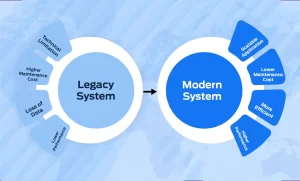
Who decides when software systems are obsolete? While no business is immune from aging systems, replacing them according to new technology trends is too expensive and not something companies want to do. It’s worth highlighting that as long as business systems perform the functions they are meant to do, there is no need to “replace” systems. This is particularly true if replacing a legacy system would not bring in identifiable gains. However, there are clear cases when an upgrade or replacement is pretty evident. This could be either because maintaining the existing tech is difficult or because new functionality is needed that cannot be supported by existing tech systems.
3 different types of Legacy Application Modernization
As organizations embrace digital transformation strategies, different parts of existing systems can be upgraded rather than going for a time-consuming complete replacement. Application modernization can be of 3 types and will depend on the business goals , lag in the current application as well as data platforms.

1. Frontend first approach to app modernization
If your legacy system has been around for a decade or more, there might be sweeping changes that you would ideally want. Though it is easy to write it down as the goal, it is hard to implement especially when the existing codebase is no longer supported new ways to bring in new functionality have to be evaluated. There are 5 signs to look out for that says it is time to engineer your system, have a look at an earlier article.
So where do you start when modernizing applications? Sometimes it can be as simple changing the UI and bringing in more functional components of the frontend application. iTech India in our legacy application modernization services have worked with clients who want to keep risk as low as possible. In such instances, a variation of the strangler pattern works best. Picture this, painting one picket of a fence at a time, is going the slow and steady way but in a fairly short time, the picket fence will be newly painted. Starting by modernizing frontend applications also fits with the Agile Methodology where there are regular release cycles that deliver quick results at regular intervals. This gives immediate results to the end user rather than sweeping structural changes.
“Software development has firmly established the principles of
the selective modernization of individual components and
business capabilities along with maximum reusability.” –
McKinsey
Frontend application modernization solves obvious pain points of users but also solves inherent issues such as
- Legacy systems may not be able to leverage many of the modern browser functionality providing a poor user experience.
- Older applications cannot connect to new libraries and frameworks and this prevents optimal functionality
- A friendlier user interface(UI) and faster loading times can help organizations reap higher revenues faster.
To sum up, a new front end is not just splashing on a new coat of paint, it improves functionality. For example, in the banking business, a new UI can bring together better functionality that makes client credit approval easier and improves onpage conversion. Because a front-end approach can focus on a single portion of the front end, getting started is easier. Updating the UI, information architecture, and supporting technologies can then be moved forward to other sections of the front end.
2. Code modernization
Application source code can become unmanageable because of code patches that have built up over time or as a consequence of older programming languages that are not compatible with new libraries. When it comes to modernizing an existing code base there are 2 options to consider:
- Rewrite code completely and add new functionality as needed. It is comparatively straightforward since developers start over and write new code from scratch. It opens the door for new platforms and technologies. The advantage of a rewrite is that it completely kills legacy code. Rewrites however take time and so organizations should commit to a rewrite only if they have the time to rebuild the application’s code.
- Code Refactoring is changing the internal structure of the code without changing functionality eg. removing redundant code or breaking up a task-heavy component into smaller containers each with a single functionality. However, code refactoring does not fix underlying architectural issues. A code written in Visual Basic will still be written in Visual Basic. All it does is change complex functions into simpler ones and that makes it easier to understand. Read our guide to code refactoring.
3. Application Architectural Modernization
A simple analysis of your application’s current state will make it obvious whether the systems architecture needs to be modernized:

Most legacy systems are built on a monolithic architecture while modern applications leverage a microservices architecture. Monolithic architecture-based applications are difficult to maintain because even a tiny code change will require scaling the complete architecture. This is because the entire system is heavily interconnected. Migrating from a monolithic to microservices architecture is best for enterprise level applications where development teams are organized into smaller teams, each focusing on different microservices. It also is a viable option when partnering with technology vendors.
A microservices architecture otherwise known simply as microservices is the building block for modern digital transformation strategies. The principle followed here is to break down large monolithic applications into smaller independent containers. Each microservice will have its realm of responsibility.
An application can call together many microservices to serve a response to a request. For instance, in an eCommerce application, you could have 3 microservices
- First microservice is for maintaining and updating a product catalog.
- The second microservice is a recommendation engine. It creates relationships between products based on customer behavior.
- The third is a price engine that sets up prices and maintains discount updates for each product

Microservices architecture in eCommerce application
These microservices will be loosely coupled and communicate with each other through API gateways or Application Programming interfaces. By developing each function as an independent microservice, developers can focus on scaling each microservice or adding new functionalities without worrying about dependencies.
Modern applications are all built on a cloud-native microservices architecture. Read more about the microservices architecture in an earlier article that dives deep into the benefits.
Almost all organizations coming to us for application modernization have a common thread – they are facing some problems with the current state of their technology and the true value we can provide them is through modernization solutions that take them comfortably to their future state. In fact, any older technology that presents a higher level of risk due to cybersecurity vulnerabilities or requires cumbersome workarounds to integrate with newer offerings should be at the top of your modernization priority list.

Biju Narayanan
Biju is an emphatic people management leader and works by the vision that change is the door to new opportunities and innovation. As Director, he has been guiding iTech on a path of innovation for over 19 years. iTech is a full-service custom software company with a large portfolio of successful domestic and international projects including Fortune 500 organizations. Biju specializes in the healthcare, sports and logistics industries with particular focus on AI and ML. Outside of work, you may find him hitting a lethal jump smash on the badminton court and he is also a creative artist.







